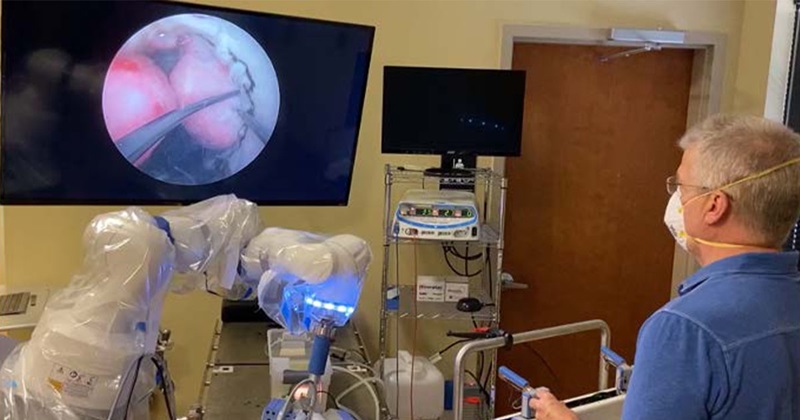Breakthrough Robot Technology Could Allow Entire Surgery to Be Performed Without Human Intervention
|
By HospiMedica International staff writers Posted on 30 Sep 2024 |

Current surgical robotics technologies typically rely on two main automation techniques. The first is model-based automation, where procedural steps and conditions for starting or stopping are pre-programmed. The second method involves machine-learning algorithms, which require vast datasets of procedures and task sequences. While both approaches have contributed to advancements in surgical robotics, they face limitations in scalability, generalizability, and adaptability. Now, a groundbreaking multi-institutional project aims to revolutionize robotic surgery by integrating model-based and learning-based approaches for the first time. This will enhance the adaptability, scalability, robustness, and interpretability of automation in surgery.
The project involving a team of robotics experts and surgeons from the University of Tennessee (Knoxville, TN, USA) aims to develop a surgical robot capable of performing an entire surgery without human intervention. This leap forward is made possible by a new technological breakthrough called concentric tube robots. These needle-sized robots can bend and elongate like tentacles, consisting of a series of telescoping, curved, super-elastic tubes that rotate within each other. The researchers will develop computational models that simulate tissue and robot movement during surgery, using these models to guide the automated system through artificial intelligence (AI) training, motion planning, and mapping the surgical environment.
The goal is to enable the new surgical robot to perform less invasive and more effective surgeries in anatomical areas that are currently inaccessible to existing surgical robots. This includes procedures like tumor removal from the trachea and prostate without direct surgeon intervention. Additionally, the researchers envision this technology being applied to other conditions such as uterine fibroids, bladder tumors, spinal procedures, and brain cysts, expanding the potential impact across various clinical applications.
“This project will endow surgical robots with autonomy, much further than has ever been done before, and with a robot that is an order of magnitude smaller than current commercial surgical robots,” said Caleb Rucker, an associate professor, and B. Ray Thompson Professor in the Department of Mechanical, Aerospace, and Biomedical Engineering. “Surgical robot autonomy can bring many potential benefits to patients by increasing safety and offloading the surgeon’s physical and cognitive workload.”
Related Links:
University of Tennessee
Latest Surgical Techniques News
- Intravascular Imaging for Guiding Stent Implantation Ensures Safer Stenting Procedures
- World's First AI Surgical Guidance Platform Allows Surgeons to Measure Success in Real-Time
- AI-Generated Synthetic Scarred Hearts Aid Atrial Fibrillation Treatment
- New Class of Bioadhesives to Connect Human Tissues to Long-Term Medical Implants
- New Transcatheter Valve Found Safe and Effective for Treating Aortic Regurgitation
- Minimally Invasive Valve Repair Reduces Hospitalizations in Severe Tricuspid Regurgitation Patients
- Tiny Robotic Tools Powered by Magnetic Fields to Enable Minimally Invasive Brain Surgery
- Magnetic Tweezers Make Robotic Surgery Safer and More Precise
- AI-Powered Surgical Planning Tool Improves Pre-Op Planning
- Novel Sensing System Restores Missing Sense of Touch in Minimally Invasive Surgery
- Headset-Based AR Navigation System Improves EVD Placement
- Higher Electrode Density Improves Epilepsy Surgery by Pinpointing Where Seizures Begin
- Open-Source Tool Optimizes Placement of Visual Brain Implants
- Easy-To-Apply Gel Could Prevent Formation of Post-Surgical Abdominal Adhesions
- Groundbreaking Leadless Pacemaker to Prevent Invasive Surgeries for Children
- Spectroscopy Technique Improves Surgery for Pediatric Epilepsy Patients
Channels
Critical Care
view channel
Ingestible Smart Capsule for Chemical Sensing in the Gut Moves Closer to Market
Intestinal gases are associated with several health conditions, including colon cancer, irritable bowel syndrome, and inflammatory bowel disease, and they have the potential to serve as crucial biomarkers... Read moreNovel Cannula Delivery System Enables Targeted Delivery of Imaging Agents and Drugs
Multiphoton microscopy has become an invaluable tool in neuroscience, allowing researchers to observe brain activity in real time with high-resolution imaging. A crucial aspect of many multiphoton microscopy... Read more
Novel Intrabronchial Method Delivers Cell Therapies in Critically Ill Patients on External Lung Support
Until now, administering cell therapies to patients on extracorporeal membrane oxygenation (ECMO)—a life-support system typically used for severe lung failure—has been nearly impossible.... Read morePatient Care
view channel
Portable Biosensor Platform to Reduce Hospital-Acquired Infections
Approximately 4 million patients in the European Union acquire healthcare-associated infections (HAIs) or nosocomial infections each year, with around 37,000 deaths directly resulting from these infections,... Read moreFirst-Of-Its-Kind Portable Germicidal Light Technology Disinfects High-Touch Clinical Surfaces in Seconds
Reducing healthcare-acquired infections (HAIs) remains a pressing issue within global healthcare systems. In the United States alone, 1.7 million patients contract HAIs annually, leading to approximately... Read more
Surgical Capacity Optimization Solution Helps Hospitals Boost OR Utilization
An innovative solution has the capability to transform surgical capacity utilization by targeting the root cause of surgical block time inefficiencies. Fujitsu Limited’s (Tokyo, Japan) Surgical Capacity... Read more
Game-Changing Innovation in Surgical Instrument Sterilization Significantly Improves OR Throughput
A groundbreaking innovation enables hospitals to significantly improve instrument processing time and throughput in operating rooms (ORs) and sterile processing departments. Turbett Surgical, Inc.... Read moreHealth IT
view channel
Printable Molecule-Selective Nanoparticles Enable Mass Production of Wearable Biosensors
The future of medicine is likely to focus on the personalization of healthcare—understanding exactly what an individual requires and delivering the appropriate combination of nutrients, metabolites, and... Read more
Smartwatches Could Detect Congestive Heart Failure
Diagnosing congestive heart failure (CHF) typically requires expensive and time-consuming imaging techniques like echocardiography, also known as cardiac ultrasound. Previously, detecting CHF by analyzing... Read moreBusiness
view channel
Expanded Collaboration to Transform OR Technology Through AI and Automation
The expansion of an existing collaboration between three leading companies aims to develop artificial intelligence (AI)-driven solutions for smart operating rooms with sophisticated monitoring and automation.... Read more
















